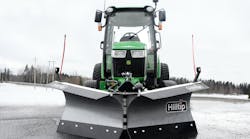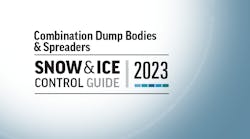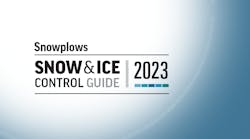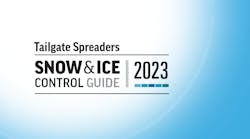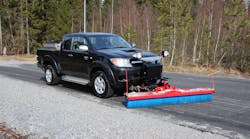CARNEGIE Body president Richard Sippola said his company examined its inventory a year ago and realized that it had way too much. Company executives decided to sell some products online, focusing on eBay. They got aggressive and watched the money pour in.
“In the last 12 months, we've sold over $100,000 worth of products online,” he said. “This was slow-moving inventory. We made about 10-12% gross profit. Not bad, considering some of the inventory had been on the shelves five to 10 years. Most of our sales occurred in other territories, not Cleveland (their home base). We had sales from England, Canada, Pennsylvania, Hawaii, Massachusetts, Colorado. Over 90% of the sales were outside of our home state. This is an opportunity for you to not only get rid of slow-moving inventory, but expand your market presence.”
The presentation, “Online Sales: Get Your Share,” also featured Layton Truck Equipment general manager Steve Hayes.
Hayes said Layton pondered online sales for about five years before getting active two years ago.
“We had a lot of growth the past five to 10 years,” he said. But the parts department was not growing at the same pace as the rest of the company. We looked at that and said, ‘Why is that happening?’ Sam's Club and Home Depot were selling toolboxes. Years ago, pickups on dealer lots didn't have hitches on them — and now they all come with hitches and brake controls.
“We saw people buying stuff online and not buying from us. So we said, ‘This is something we think we need to get into. How do we want to get into it?’ The first thing we said was, ‘Let's develop our own Web site.’ The other option was eBay.”
Hayes said there are advantages to creating your own Web site: you control the look and feel of the site; save the fees paid to other sites; can integrate with your current accounting platform; know that it works well for customers who know who you are; and that there's no competition once you have them on your site.
The disadvantages: there is a programming and development cost, and a cost to drive traffic to your site; you must maintain your own server or pay for that service; customers may not trust you if they don't know you.
“You have to get people to your Web site,” Hayes said. “That's something you have to spend money to do if you develop your own Web site.”
He said software development can run from a few hundred dollars to the tens of thousands.
“You see ads on TV: ‘Get your Web site running in two days for $25.’ Realistically, our cost was between $10,000 and $20,000. The up-front cost for the server is $2500, plus maintenance fees to keep the server running, and connection fees.”
Driving traffic
How do you drive traffic to your Web site?
“Google Ad Words is an inexpensive method,” he said. “You can set your budget and pay on a cost-per-exposure basis. Depending on what you're selling, they will give you a cost per exposure or cost per click. You say, ‘OK, it's a dollar to get somebody to click on. At the beginning of the day, when somebody searches ‘snowplow’ or whatever you're trying to sell, you come up with a sponsor list. The cost of that referral comes off your daily budget. When you have spent the budgeted amount for the day, your sponsored listing will disappear. That's an effective tool. We've used it well to drive people to our Web site.”
Then there's the option of using an existing Web site. The advantages: there are no programming/development costs and no Web site-hosting costs; customers already shop there; and they may perceive additional security if they are familiar with the site.
“If they don't know you, they don't know what you will do with their credit card information,” he said. “That's a valid issue for a lot of online buyers. That's something the online sites have addressed very well. The biggest thing we've found is that the customers are there. Go where the customers are.”
The disadvantages: fees may be charged, because the existing sites are all in there to make a profit; you can't control the policies in place so you have to conform to them; your competition may be using the same site; and there is negative feedback if you don't perform.
Next Page: eBay has worked
“And in the eBay world, negative feedback will take you out of the game,” Hayes said. “You need to have 98-99% positive feedback if you want somebody to consider you as a supplier. You have to do what you say you will in a timely fashion, or you get killed.”
He said if you aren't going to create your own site, then you need to evaluate which existing sites make sense for you. Where are people already shopping for products like yours? Do they have the traffic so that your items get exposure? Do they have policies that protect the buyer and the seller?
“I had an interesting personal experience recently while shopping online for a movie,” Hayes said. “I finally find a Web site that has downloadable movies. They have a 99-cent, one-day trial. I (later) checked my debit account and didn't see 99 cents. I didn't see it the next day. I checked the next day and saw a charge for $53. I went back into Google and searched the name and found it's a rip-off. I did get the charge reversed, but there is that fear, ‘Is the company reputable? Are they going to take care of you or rip you off?’ That's why existing sites like eBay have so much success.”Other existing Web site options:
-
Craigslist. “We haven't had very good results. My experience is, there are a lot of people not serious about what they're doing.It's not monitored. It's a free site, and the contact is directly with sellers.”
-
Amazon.com. “Not much content for an industry like ours.”
-
Online classifieds for newspapers in other areas or your local newspaper.
eBay has worked
Hayes said eBay has been the best choice for Layton Truck Equipment because it has national/international reach, is widely recognized and reputable, buyer and seller protection is a big factor for a lot of people, and it's open 24 hours a day, seven days a week.
“It is a great way to get rid of stale or outdated inventory,” he said. “You reach out to a larger client base for items you sell and bring in new customers that are outside your market. If you have a customer that doesn't live near a company that sells what you're offering, they don't want to drive 40 miles. They'd rather buy online and have it delivered by UPS truck three days later.”
He provided some mind-boggling numbers on eBay: 600,000 items are added each day; approximately nine million people view eBay a day; and it has over 100 million listings at any given time.
Sippola said these resources are needed to operate on eBay: high-speed Internet access; digital camera; five hours a week to handle phone calls and questions; e-mail access; shipping services; and a bank account/credit-card account to accept payments.
To get started, register as an eBay member by using the name of the company, become an eBay seller, provide ID verification with eBay, and choose a method of payment: PayPal (fees will be deducted from sales), credit or debit card (“easier for accounting”), or bank account.
Sippola said PayPal is a secure online payment service with the only requirement being an e-mail address. It's one of the most trusted online payment services, with 70 million active accounts and is integrated seamlessly into eBay listings, so the buyer simply clicks the PAY NOW button.
“Keep in mind that a lot of buyers are first-time customers — they're probably not familiar with your company,” he said. “Ninety percent of the listings offer PayPal. It's just an easier way to make it work.”
It's fast: You receive and send money quickly, and there is no waiting for checks or money orders.
It's easy: You can accept payments from credit cards, increase the volume of sales, and satisfy the safe-payment requirement.
It's secure: It keeps your financial information secure from sellers and merchants, uses the strongest encryption commercially available, and helps protect you from fraudulent transactions.
Once you have the PayPal account set up, you can list items for sale on eBay.
“Research what you're going to sell,” Sippola said. “You can get online and type in the item and see what others are selling it for, and the history that will give you an idea of what the pricing should be. Input your listing and the starting price or reserve price, method of payment, and shipping information. We find that when dealing with items that have a cost for us of less than $50, it generally is not worth it to do an eBay listing, because it's too much work for the reward. At the same time, it's hard to sell very large items if they're going to be difficult to ship.”
He said it's always beneficial to link your e-mail account to your eBay account.
“A lot of times people e-mail you at night,” he said. “There may be a snowplow contractor that's sleeping in the morning because he was out all night plowing. He might be looking to fix a truck at 9 at night. If you're available to reply, they really like that, and you get sales out of that. Otherwise they may move on to next company.”
When listing, make your item as easy to find by using relevant key words, provide a lot of details (dimensions, color, materials, age/condition), include a good picture, be honest and disclose any defects (show the defects in a picture, if possible), and make sure your policies are clearly stated (payment options, shipping terms and handling time, return and refund policy).
“If you're honest with them, they can't come back and complain,” he said. “If you're dishonest, then you're going to get ripped on the feedback, and it will be difficult to sell on eBay.”
Fees for selling on eBay include:
- Insertion (listing fees)
They vary for auction-style listings, are charged when you list the item, and are sometimes waived based on the activity of your account. There are normally five free insertions per month.
- Optional listing upgrade fees
On bigger auction-style listings such as winches or snowplows, he suggested using “Featured Plus,” which upgrades the listing to show up at the top of the same page it would normally show up in search results; or “Featured First,” which upgrades your listing for the opportunity to show up at the top of the first page of search results.
- Final-value fees
They're based on the item's selling price. No fee is charged if the item doesn't sell.
- PayPal fees
They're based on 2.9% of the selling price, plus 30 cents.
